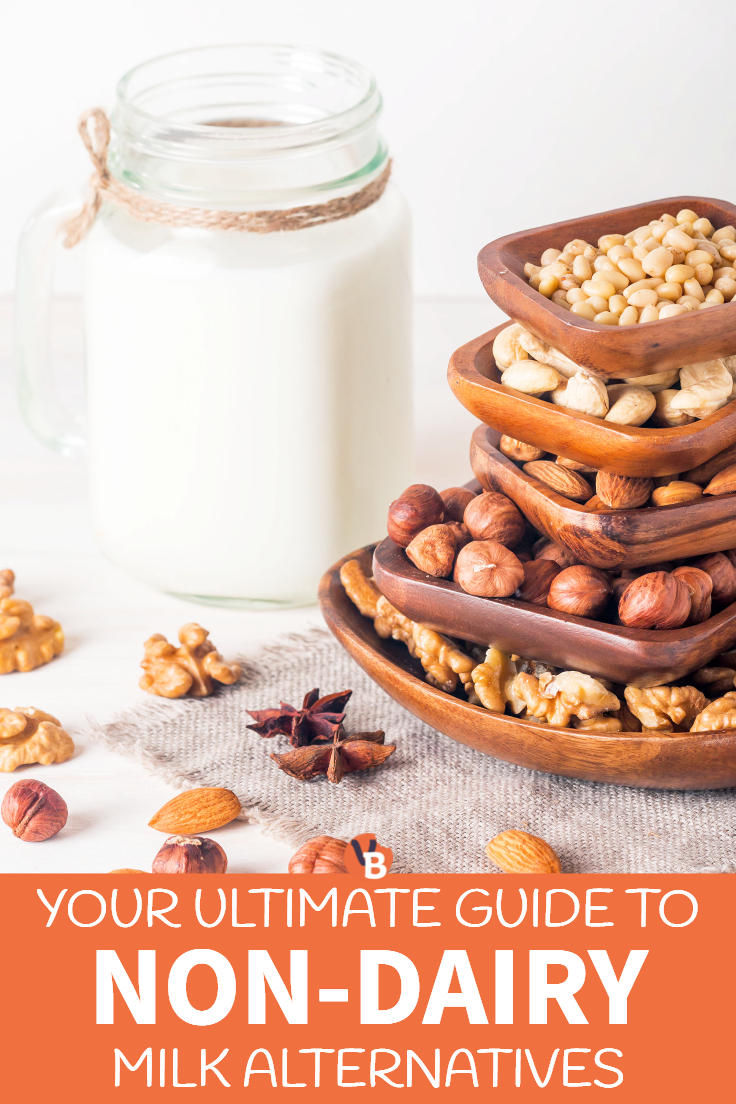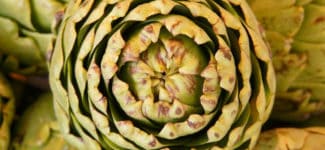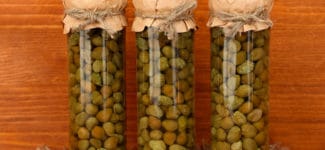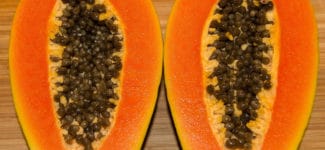I’ll break down everything you need to know about non-dairy milk alternatives so you can make your own.
You’ll also learn which options are best for different purposes, like cereals, soups, coffee, etc.
What You Need to Know About Non-Dairy Vegan Milk Alternatives
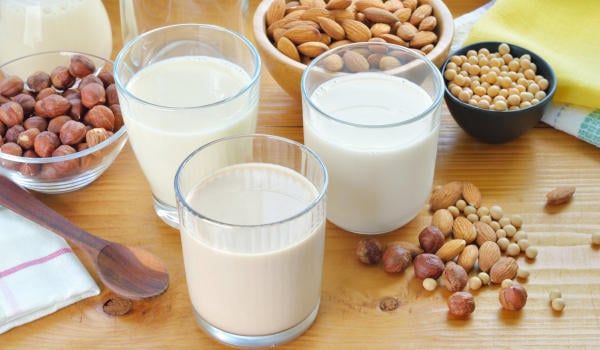
Non-dairy milks are milk-like beverages but they don’t come from animals. Instead, they’re plant-based milks made by blending various nuts, seeds, grains or beans with water and then straining out the fiber.
Most manufacturers include additional ingredients to their final product to enhance the flavor, texture, and shelf-life. It’s best to choose brands that use the least amount of extra ingredients in their non-dairy milks.
Like dairy milk, plant-based milks are often fortified with additional vitamins and minerals, such as calcium and vitamin D.
For this reason, it’s a good idea to shake the carton before each use, to ensure the added nutrients are not sitting at the bottom of the carton.
While store-bought non-dairy milks are great, it can be fun to make your own milks at home. This gives you control over what, if any, extra ingredients get added.
Here’s a quick comparison between homemade and store-bought plant milks:
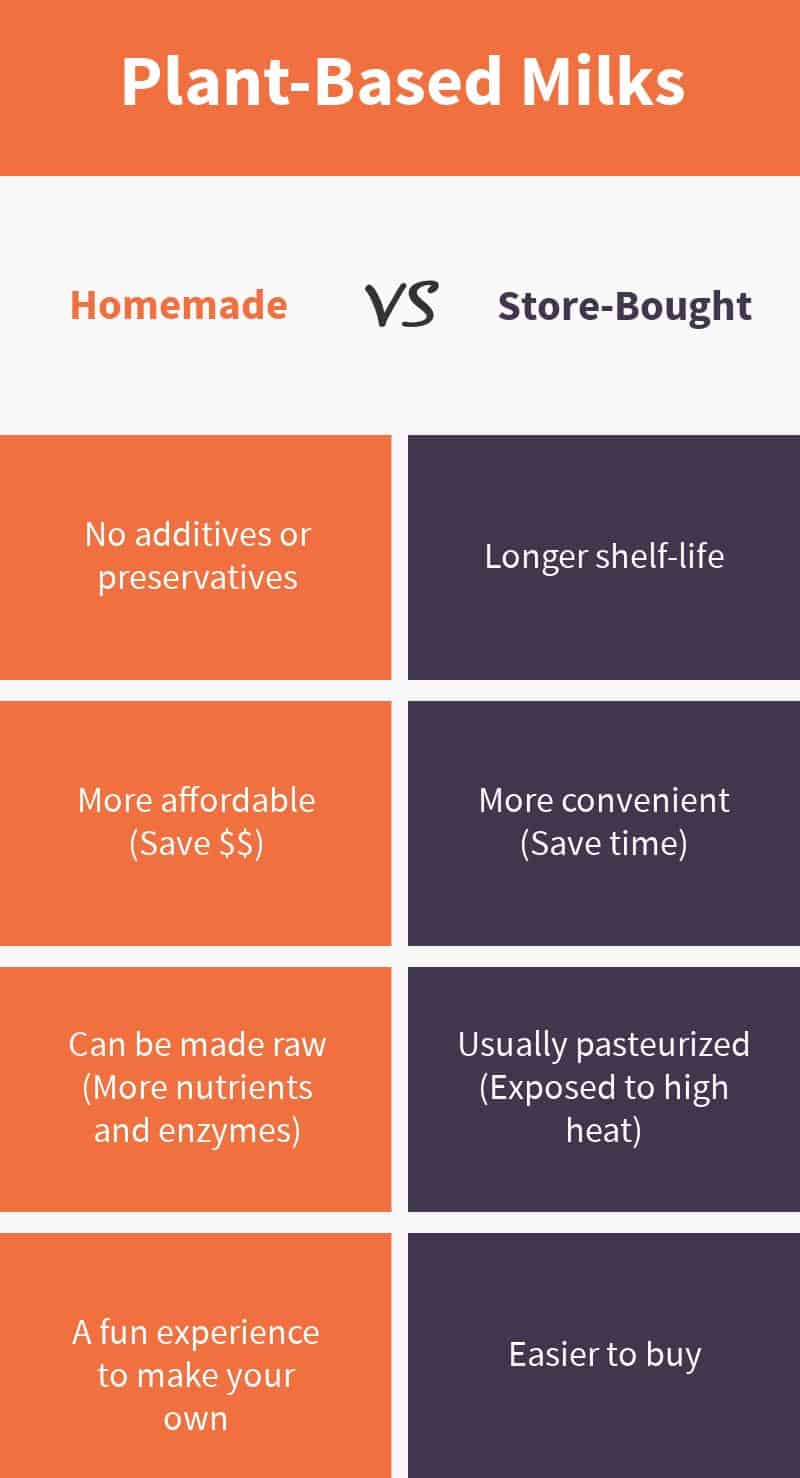
Plant-based milks can be used in all the same ways as dairy milk. Add them to your cereal, coffee, or soups, use them in baking, or enjoy them straight from the glass.
I think you’ll be amazed at how versatile and delicious they really are!
Nutritionally, they vary in protein and calories, depending on the type of plant milk you’re using. But what they all have in common is they’re antibiotic and hormone-free!
So, you can feel good about making the switch to any of the dairy-free milks available today.
16 Types of Plant-Based and Vegan Milk Substitutes You Need to Try
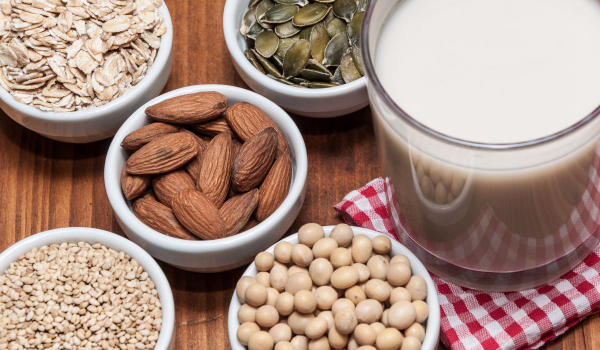
Now the biggest question is, which plant-based milk do you choose?
Not to worry, I’m going to give you a detailed run-down of the most popular options, so you know which one will be best for you.
Let’s get started!
Almond Milk: Generally Best for Adding to Cereal, Smoothies and Straight from the Glass
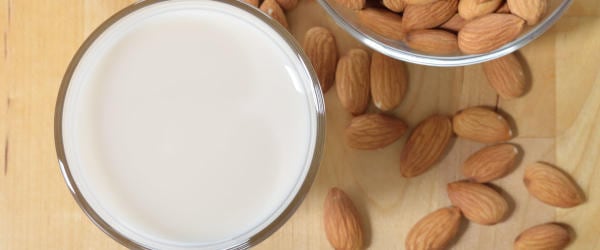
- Serving Size: 1 cup (8 oz)
- Protein: 1g; Calories: 30
How it tastes: Almond milk is the first plant milk I tried when I started my dairy-free journey. I enjoyed its creamy, yet light and nutty flavor. You can choose between original, vanilla, chocolate, sweetened, or unsweetened varieties.
What it’s great for: Almond milk is a favorite for drinking straight from the glass. But it’s also great added to coffee, cereal, smoothies, and used in cooking and baking.
For cooking and baking, the original or unsweetened flavors are best. Almond milk can be equally substituted for dairy milk, cup-for-cup, making it an easy switch.
Worth knowing: Almonds contain powerful antioxidants that help to protect the body from harmful free-radicals. To get the full nutritional benefit, it’s best to make your own homemade almond milk or include almonds as part of a healthy diet.
Cashew Milk: Generally Best for Coffee and Lattes
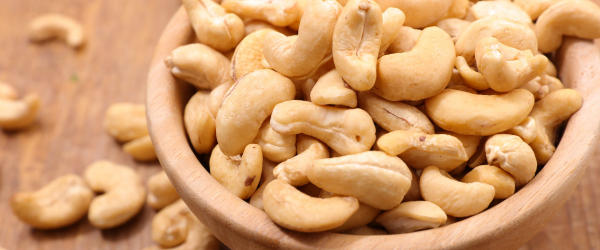
- Serving Size: 1 cup (8 oz)
- Protein: 1g; Calories: 25
How it tastes: Cashew milk has a slightly thicker consistency than many other plant-based milks. This is a smooth and slightly sweet milk with a nutty undertone. Cashew milk comes in original, vanilla, chocolate, sweetened, or unsweetened varieties.
What it’s great for: Due to its creamy consistency, cashew milk goes great in coffee. It’s also a great plant milk to drink straight from the glass or in a smoothie.
Worth knowing: Cashews are not nuts, but seeds of the cashew apple tree. Who knew!?
Coconut Milk: Generally Best for Soups, Curries, and Sauces
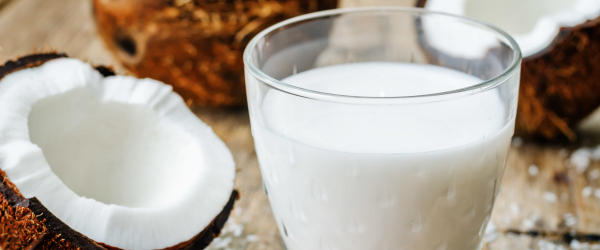
- Serving Size: 1 cup (8 oz)
- Protein: <1g-1g; Calories: 45-360+
How it tastes: Coconut milk has a rich, floral and coconut flavor. Depending on the brand of coconut milk you’re looking at, the taste and thickness can vary.
Brands like So Delicious and Pacific have a thinner, lower calorie coconut milk (found in the refrigerated section) compared to brands like Native Forest or Thai Kitchen’s thicker more concentrated, canned versions.
What it’s great for: The thinner versions you’ll find in the refrigerated section of the grocery store are great for drinking straight from the glass. They also work great in cereal and smoothies. The canned, higher-fat versions are best for soups, curries, and sauces.
Worth knowing: While it’s quick and easy to buy coconut milk from the store, I must tell you the most delicious coconut milk I have ever experienced I made at home using a fresh coconut.
I also enjoy making it with dehydrated coconut shreds but using fresh coconut meat is my favorite. If you ever get the urge to make homemade coconut milk, you’re in for a treat!
Flaxseed Milk: Generally Best for Cooking, Baking or Straight from the Glass
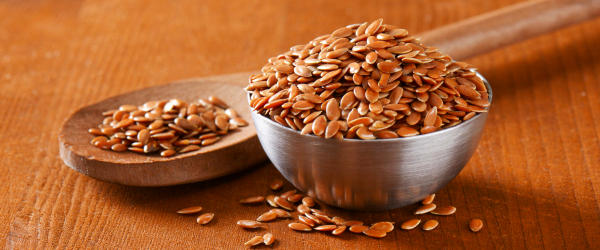
- Serving Size: 1 cup (8 oz)
- Protein: 1g; Calories: 50
How it tastes: Flax milk is my favorite of all the plant milks! It’s smooth and creamy with a slight sweetness to it. Flax has a natural gelatinous consistency to it when it’s in liquid, which gives it that nice creaminess.
There‘s a slight nuttiness to this plant milk, but overall, it’s a neutral flavor that goes well with almost anything you want to use it with.
What it’s great for: Flax milk is a perfect substitute for dairy milk in cooking and baking. It’s creaminess also makes it a great addition to coffee, tea, or smoothies. Personally, I love it straight from the glass!
Worth knowing: Flax is known for its healthy omega-3 fats, which are also in flax milk. Most people don’t get nearly enough omega-3’s, so flax milk is a terrific way to help do so.
Flax milk is also one of the most inexpensive and easy plant milks to make at home. This is great because it isn’t as well-known as other non-dairy milks, so some grocery stores may not carry it.
Hazelnut Milk: Generally Best for Coffee, Lattes, and Smoothies
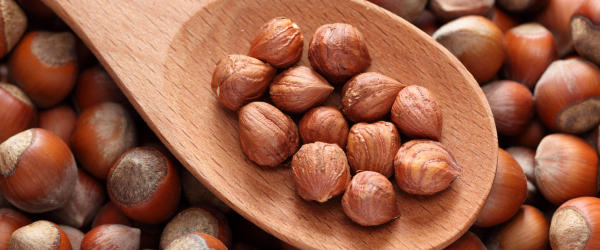
- Serving Size: 1 cup (8 oz)
- Protein: 3g; Calories: 100
How it tastes: Hazelnuts have traditionally been used an ingredient in desserts and other sweet dishes. Really, who can resist rich, nutty, and sweet?
The high fat content and distinctly sweet and nutty flavor make hazelnuts a popular non-dairy milk option.
What it’s great for: The richness of hazelnut milk makes it a great choice for adding to coffee, smoothies, tea, cereal, desserts or drinking straight from the glass.
Try adding a couple teaspoons of carob or cacao powder for a delicious glass of chocolate milk or hot cocoa.
Worth knowing: Hazelnuts have one of the highest antioxidant levels of all the nuts. According to Dr. Michael Greger, M.D. FACLM, of NutritionFacts.org, hazelnuts rank third in his list of the healthiest nuts. Compared to some other non-dairy milks, hazelnut milk has a slightly higher protein content.
Hemp Seed Milk: Generally Best for Smoothies, Baking, and Savory Dishes
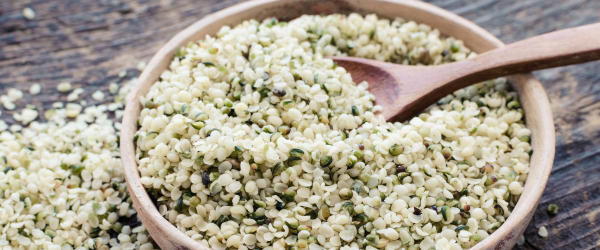
- Serving Size: 1 cup (8 oz)
- Protein: 3-4g; Calories: 60-80
How it tastes: Hemp seed milk is a full-bodied, earthy plant milk. Higher in protein and healthy fats than most other non-dairy milks, hemp milk has a creamy and nutty flavor.
What it’s great for: The creaminess of hemp milk makes it great for adding to smoothies, baking recipes, or enjoying straight from the glass. Hemp milk can also work well in savory dishes.
Worth knowing: Hemp seeds are a powerhouse in nutrition. Like flax seeds, they are high in anti-inflammatory omega-3 fats. Hemp also contains healthy amounts of iron, protein, and has fewer calories than dairy milk.
Macadamia Nut Milk: Generally Best for Coffee and Lattes
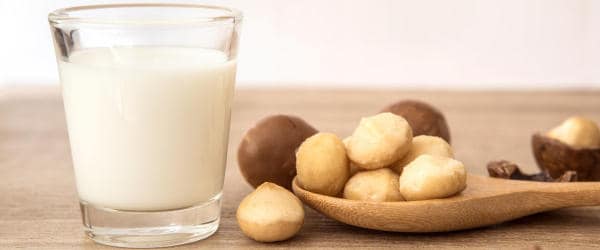
- Serving Size: 1 cup (8 oz)
- Protein: 1g; Calories: 50
How it tastes: I’ve always loved the richness of macadamia nuts and now I love their milk too! Macadamia nut milk is smooth, creamy, and slightly sweet.
Store-bought brands are a little more thin and neutral tasting than homemade but both versions are terrific dairy replacements.
What it’s great for: Macadamia nut milk is great in coffee, smoothies, cereal, or enjoyed on its own. You can also use macadamia nut milk in cooking and baking, just as you would use dairy milk.
Worth Knowing: Macadamia nuts originated in Australia but now are grown around the world. They have the highest percentage of fat out of all tree nuts. This gives this milk its rich, creamy consistency, especially in homemade versions.
Oat Milk: Generally Best for Adding to Coffee, Cereal, and Smoothies
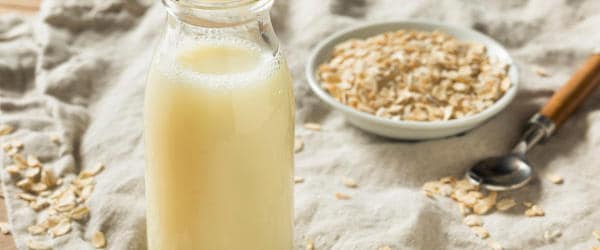
- Serving Size: 1 cup (8 oz)
- Protein: 4g; Calories: 130
How it tastes: Oat milk is another creamy, almost buttery plant milk with a pleasant hint of sweetness. The high soluble fiber content of oats lends itself to creating a thicker, milk-like consistency. Oat milk ranks towards the top of my list for best tasting plant milks.
What it’s great for: The relatively sweet and creamy nature of oat milk makes it great for adding to coffee, cereal, or smoothies. Oat milk has a slightly higher protein content than many of the other plant milks, making it a popular choice for athletes.
Worth knowing: Oats are one of the most affordable foods available, especially if bought in bulk. This makes oat milk a great non-dairy milk to create at home. It’s quick and easy to whip up and lasts two to four days in the fridge.
Pea Milk: Generally Best for Smoothies or Coffee
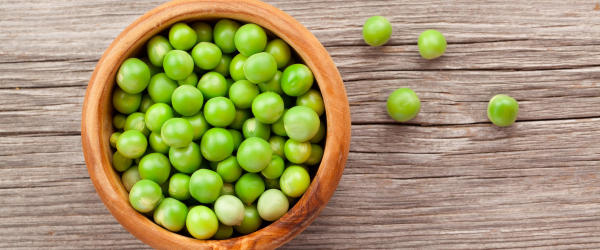
- Serving Size: 1 cup (8 oz)
- Protein: 8g; Calories: 70
How it tastes: Pea milk is one of the newest non-dairy milks on the market and might not be as easy to find as some other plant milks.
If you do find it, you’ll likely have the option to choose between original, original unsweetened, vanilla, unsweetened vanilla, and chocolate flavors. The unsweetened version is neutral and somewhat chalky while the other three flavors are much sweeter and great on their own.
What it’s great for: Pea milk is touted for its creaminess and high protein content. This makes it great for adding to smoothies, coffee, or straight from the glass.
The unsweetened versions are best used as a dairy milk replacement in smoothies, cooking, and baking. The sweetened flavors are also great in smoothies and coffee but are pleasant on their own as well.
Worth knowing: Instead of using whole peas, this plant-based milk is made with pea protein powder. This gives this milk its high protein content and thicker consistency. Currently two companies, Ripple and Bolthouse Farms, are producing pea milks you may find at your supermarket.
Peanut Milk: Generally Best for Cooking, Baking and Smoothies
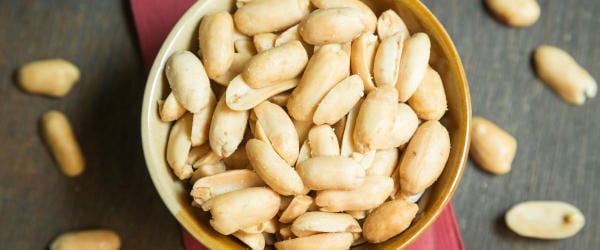
- Serving size: 1 cup (8 oz)
- Protein: 6; Calories: 150
How it tastes: Another recent addition to the plant-based milk scene is rich and creamy peanut milk. Coming in regular and chocolate flavors, peanut milk has distinct peanut flavor to it. This is a higher calorie plant milk but if you’re a peanut lover, it’s one worth trying.
What it’s great for: The hint of peanut makes this milk great for cooking and baking sweet or savory dishes. From brownies to curry, peanut milk can add a fantastic element to your culinary experience. This creamy plant milk can also make a great protein-rich addition to your favorite smoothies.
Worth knowing: It goes without saying, people with peanut allergies should avoid peanut milk. If that includes you, enjoy trying any other the other allergen free plant-milk options.
Rice Milk: Generally Best for Cereal, Coffee or Straight from the Glass
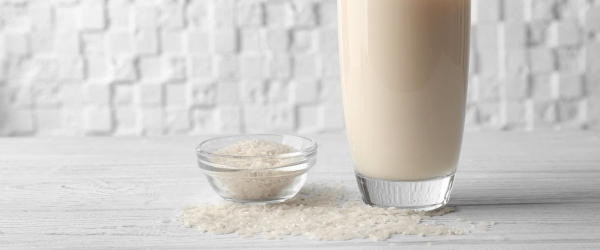
- Serving size: 1 cup (8 oz)
- Protein: 1g; Calories: 120
How it tastes: Rice milk is a thin, light, and sweet tasting non-dairy milk option. Being low in fat, it’s not as rich or creamy as some other plant-based milks. That said, it has a pleasant taste that can be enjoyed in multiple ways.
What it’s great for: The lightness of rice milk makes it great for those who are used to adding skim milk to their cereal or coffee. And its sweetness makes it popular for drinking straight from the glass.
Worth knowing: Rice milk offers a non-allergenic option for those with food sensitivities to nuts, soy, or dairy.
Sesame Seed Milk: Generally Best for Savory Soups, Curries, and Sauces
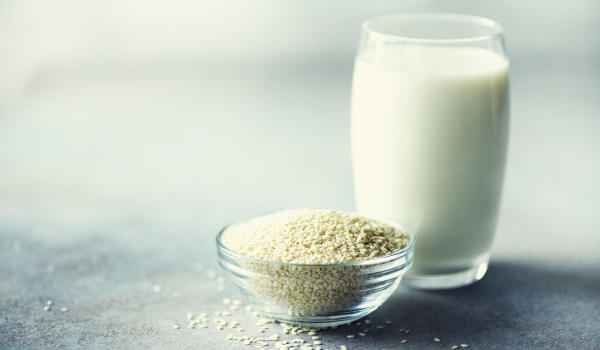
- Serving size: 1 cup (8 oz)
How it tastes: Sesame seed milk is not available to buy in stores that I’m aware of. So instead, I easily make it at home with 1 cup of sesame seeds and five cups of water and it turns out fantastic! The sesame seeds give the milk a nutty, earthly flavor. A pinch of salt and 2 medjool dates take the milk from slightly bitter to smooth and delightful.
What it’s great for: The nutty and earthy flavor of sesame seed milk makes it great for adding to savory dishes. Use it in your savory soups, curries, and sauces to create delectable meals. Personally, I enjoyed drinking this milk straight from the glass as well.
Worth knowing: Sesame seeds are great sources of copper, manganese, calcium, and much more. Making your own plant milk is a great way to get the full nutritional benefits of the plants that may be missing in store-bought milks.
Spelt Milk: Generally Best for Cooking and Baking
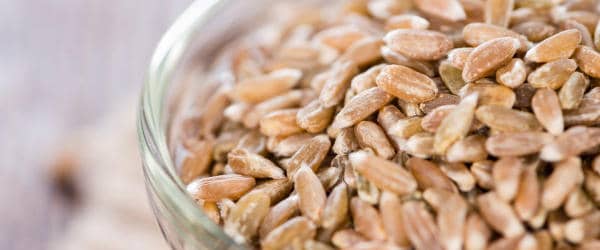
- Serving size: 1 cup (8 oz)
- Protein: 1g; Calories: 60
How it tastes: Spelt milk is comparable to oat milk but not as thick and slightly more neutral in taste.
What it’s great for: Spelt milk’s neutral taste makes it great for many applications. Use it in cooking and baking as well as in smoothies and cereal.
Worth knowing: Spelt is in the same family as wheat and contains gluten. People with celiac disease or gluten sensitivities should avoid using spelt milk.
Soy Milk: Generally Best for Cooking, Baking and Smoothies
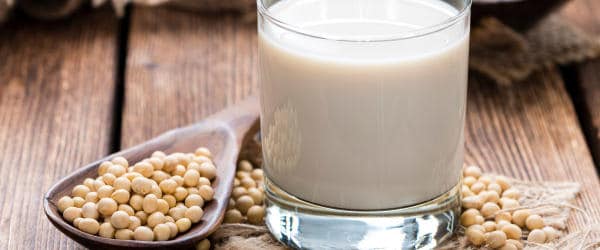
- Serving size: 1 Cup (8 oz)
- Protein: 7g; Calories: 100
How it tastes: Soy milk is smooth and creamy with a hint of sweetness. The consistency, mouth-feel and even protein content is very comparable to dairy milk. The taste of soy milk can vary depending on the manufacturer, so consider trying multiple brands to find one suitable to your taste.
What it’s great for: Soy milk is a versatile non-dairy milk that can be used in virtually any situation dairy milk is used. It’s particularly great for replacing dairy milk in cooking and baking recipes. Its high protein content makes it a popular dairy replacement in smoothies or for drinking by itself.
Worth knowing: Soy is the second most common genetically modified (GM) crop in the United States. Health and safety concerns have been raised about the consumption of GM crops which have even been banned in several countries. To avoid genetically modified soy milk, always buy certified organic whenever possible.
Sunflower Seed Milk: Generally Best for Cereal, Coffee, or Enjoyed Alone
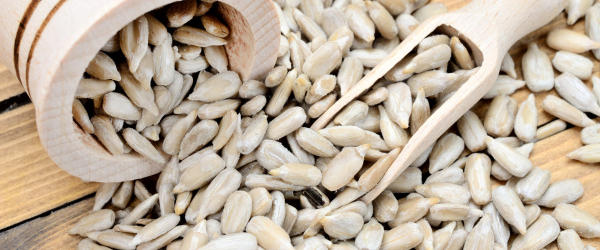
- Serving size: 1 Cup (8 oz)
How it tastes: Sunflower seed milk is surprisingly tasty! I made a batch tonight with a cup of sunflower seeds, two medjool dates, and 5 cups of water – I was blown away! It’s light in consistency with the delicate nuttiness of sunflower seeds that blends perfectly with the sweetness of the dates.
What it’s great for: Sunflower seed milk is the perfect non-dairy milk for adding to your morning cereal. The hint of sunflower seeds would be a great addition to your coffee or latte. And you can’t go wrong sitting down to a nice cold glass of sunflower milk all on its own.
Worth knowing: Sunflower seeds are very affordable, making this non-dairy milk a cost-effective replacement to dairy and other alternatives. I love how fast and easy it is to make sunflower seed milk at home.
Walnut Milk: Generally Best for Coffee, Oatmeal, and Baking
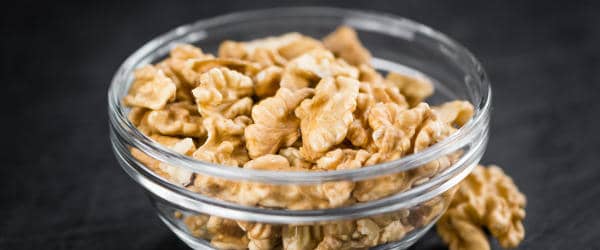
- Serving size: 1 Cup (8 oz)
- Protein: 3g; Calories: 130
How it tastes: Walnut milk is smooth and creamy with a pleasant walnut flavor. When I drink walnut milk, I feel like cozying up next to a fireplace, wearing my favorite fuzzy slippers (what, you don’t wear fuzzy slippers?).
What it’s great for: The distinct walnut flavor makes it great for adding to your morning oatmeal or porridge. You can also use walnut milk to add delicious nuttiness to your coffee or latte. And if you’re in the baking mood, walnut milk can take your banana bread or muffins to the next level.
Worth knowing: When it comes to nuts, walnuts are a great source of omega-3 fats and antioxidants. These nutrients have an anti-inflammatory effect in the body and may provide various health benefits.
How to Make Your Own Plant-Based Milks and What You’ll Need
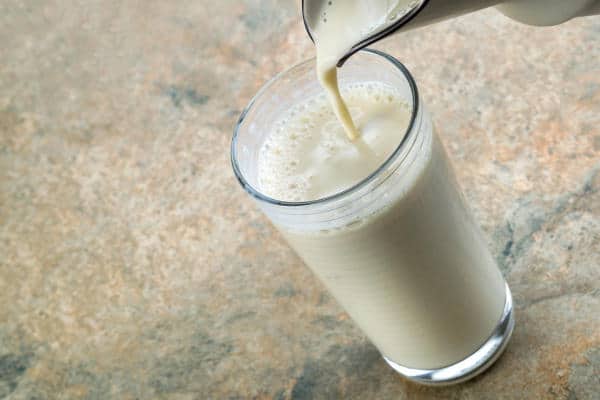
Now that you’re familiar with nearly all the non-dairy options available, let’s talk about making your own!
This is where things get fun, and surprisingly affordable. I’ve made a brief video showing you how it’s done:
Next, let’s review some benefits to making your own plant milk vs. buying it at the store:
No unwanted additives, preservatives, flavors or oils: Nearly all store-bought plant milk will contain some level of these added ingredients. By making plant milk at home you control what goes into it. This means a healthier and potentially more delicious plant milk!
Homemade is much more affordable: Buying plant milks can be expensive, especially less common varieties. For a fraction of the price you can make your own in just minutes.
Personalization: Everyone’s tastes are unique. Some like their plant milk sweet and creamy while others prefer light and neutral. You can experiment with your recipes to find the right balance for your tastes.
Variety: When you make plant milk at home, the possibilities are endless! Check out these fabulous vegan milk recipes for some delicious inspiration.
What impressed me the most when I made my own and how simple the process is. Here is all you’ll need to get started:
Blender

A high speed blender will produce the best results but any blender will work. Place your ingredients in the blender and blend for thirty to sixty seconds.
The finer you’re able to blend the nuts or seeds, the creamier your milk will be. Now you’re ready to strain the milk.
Nut milk bag and a large bowl
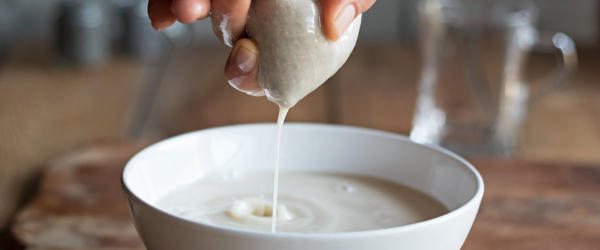
A nut milk bag allows you to remove the pulp from the milk. You can find nut milk bags at most health food stores, some regular grocery stores, or online.
Place the bag into a large bowl to catch the liquid as it strains through. Pour the blended contents from your blender into the nut milk bag and gently work out all the liquid.
Storage Container

Transfer your plant milk into a clean, air-tight container and you can store it in the refrigerator for about three to five days. I like to use glass mason jars to store my plant milks.
That’s it! It literally takes less than ten minutes to make fresh plant milk. And since this is homemade plant milk, there are a few additional things to know:
- It’s normal for the milk to separate when it’s stored. Before each use, just give it a few good shakes and you’re good to go.
- There are no preservatives, so the shelf-life is much shorter. I try to finish each batch within three to five days.
- The flavor is generally better than store-bought non-dairy milks.
- It’s best to soak nuts and seeds in clean water for about eight hours before blending them. This removes some of the bitterness and also makes them easier to blend.
- If you don’t have a nut milk bag, you can also use cheesecloth.
- Leftover pulp can be composted or used in baking recipes.
If you’re a visual person like me and want to see how it’s done, check out this short tutorial:
Which Milks Should I Use?
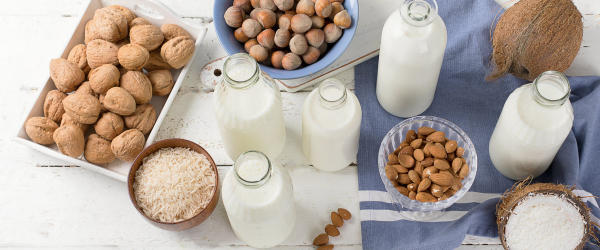
Because each non-dairy milk is unique, it’s important to know which milk works best for each intended purpose. The following sections will explain the best uses for each non-dairy milk.
What Are the Best Non-Dairy Vegan Milks for Baking?
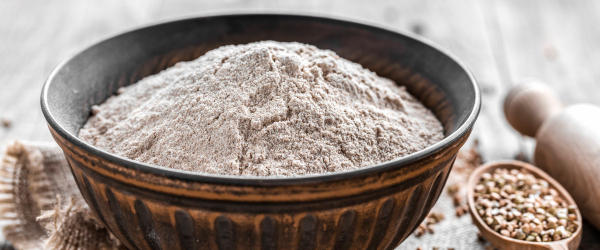
When baking, the creamier non-dairy milks work the best. If the milk is too thin, it won’t provide the same results we’re used to getting from dairy milk. Give any of these creamy milks a try in your next baking recipe:
- Soy milk: Sweet and creamy
- Hemp milk: Earthy and creamy
- Cashew milk: Slightly sweet and creamy
- Oat milk: Mildly sweet and extra creamy
- Coconut milk: Rich and floral
What Are the Best Non-Dairy Vegan Milks for Cereals?
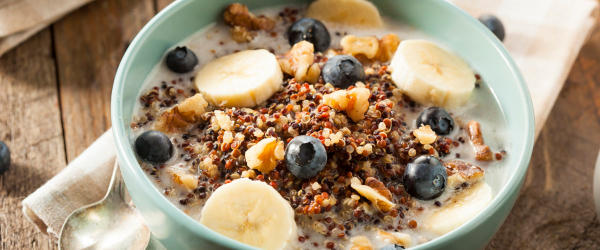
There are many great non-dairy milk options that work great for adding to cereal. It’s important to use a milk that complements the cereal and isn’t overpowering in flavor. Give any of these milks a try in your next bowl of cereal:
- Almond milk: Light and nutty
- Oat milk: Mildly sweet and extra creamy
- Soy milk: Sweet and creamy
- Sunflower milk: Light and savory
- Flax milk: Nutty and creamy
What Are the Best Non-Dairy Vegan Milks for Coffee?

If you’ve never tried non-dairy milk in your coffee, you’re missing out!
Not only can they add creaminess to your brew but also undertones of nuttiness, depending on the milk used. Try adding any of these non-dairy milks to your next “cup of joe”:
- Soy milk: Sweet and creamy
- Oat milk: Mildly sweet and extra creamy
- Macadamia milk: Creamy and nutty
- Cashew milk: Slightly sweet and creamy
- Hazelnut milk: Rich and creamy
What Are the Best Non-Dairy Vegan Milks for Tea?

Like coffee drinkers, tea enthusiasts are very particular about what goes into their tea. Some like it creamy, some like it sweet, and some prefer their tea neutral.
However you like it, these non-dairy milks can be a pleasant addition to your next cup:
- Oat milk: Mildly sweet and extra creamy
- Soy milk: Sweet and creamy
- Hemp milk: Earthy and creamy
- Cashew milk: Slightly sweet and creamy
- Almond milk: Light and nutty
What Are the Best Non-Dairy Vegan Milks for Smoothies?
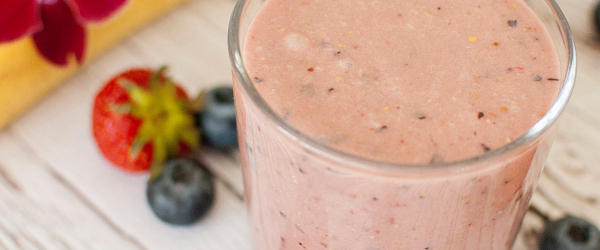
Who doesn’t love a refreshing, creamy smoothie? Many juice and smoothie shops are opting to replace dairy-milk with more popular non-dairy milks in their smoothies.
And why not, when you can have all the same creamy deliciousness, without any of the nasties found in commercial dairy products? Try these creamy non-dairy milks in your next smoothie:
- Coconut milk: Rich and floral
- Hemp milk: Earthy and creamy
- Soy milk: Sweet and creamy
- Flax milk: Nutty and creamy
- Peanut milk: Rich and creamy
What Are the Best Non-Dairy Vegan Milks for Soups?
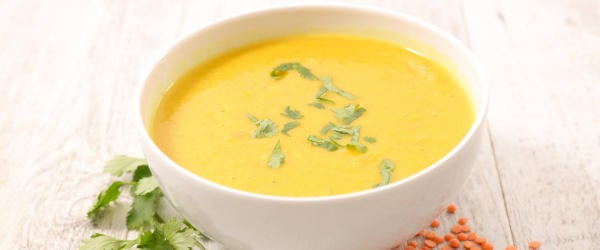
You can make some really delicious soups with non-dairy milks.
Any recipe that calls for dairy milk, there is a comparable non-dairy milk that can take its place. Try using one of the following non-dairy milks in your next soup:
- Coconut milk: Great for curries and chowders
- Soy milk: Sweet and creamy
- Almond milk: Not as creamy as soy milk but still adequate for most soups
- Cashew milk: Creamy and slightly sweet
- Sesame milk: Nutty and savory
Wrapping Up
So, there you have it!
Some of the most common, and not so common, plant milks available for your dairy-free enjoyment. Plant milks are versatile, delicious, and offer a healthy alternative to dairy milk.
It’s more convenient today then ever before to purchase non-dairy milks, as supermarkets try to keep up with the demand. And if you don’t happen to find the one you want, you can easily make it at home!
These homemade milks are fast, easy, and very affordable to make yourself. With the information in this article, I hope you now feel confident to give it a try. You’ll be surprised how delicious they can be!
While I’ve given you plenty of suggested uses for each plant milk, I encourage you to do your own experimenting. You may find that you enjoy using each kind differently than what I’ve laid out in this article.
Go ahead and let me know what your favorite non-dairy, vegan milks are and how you like to use them!

